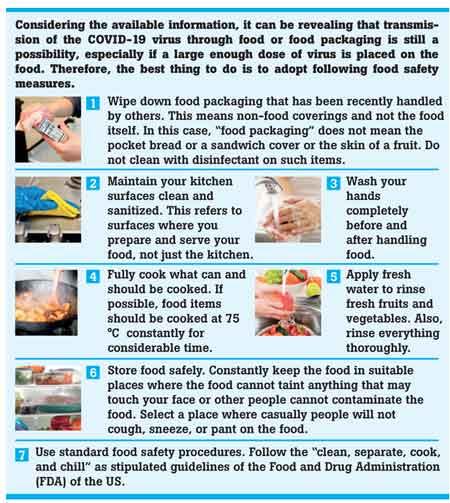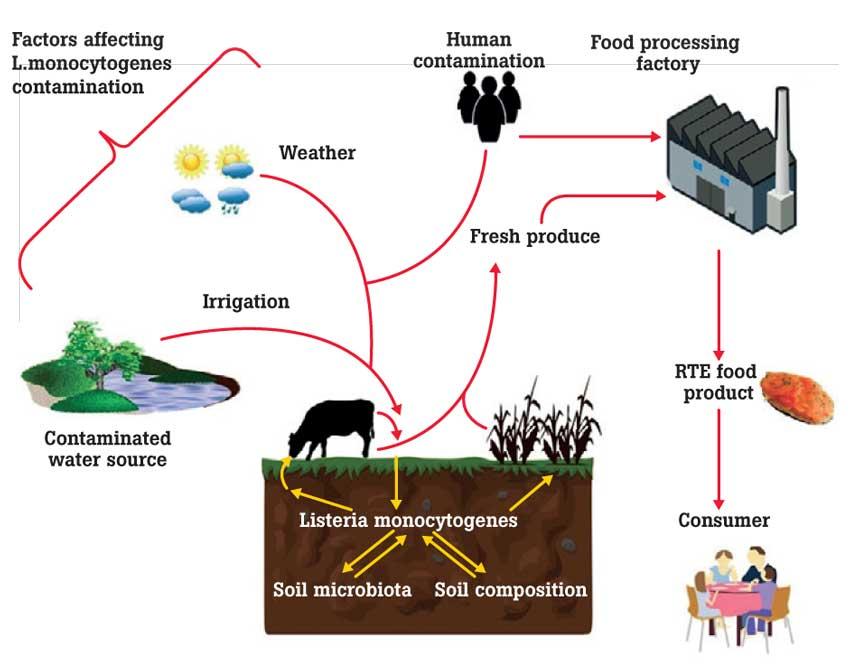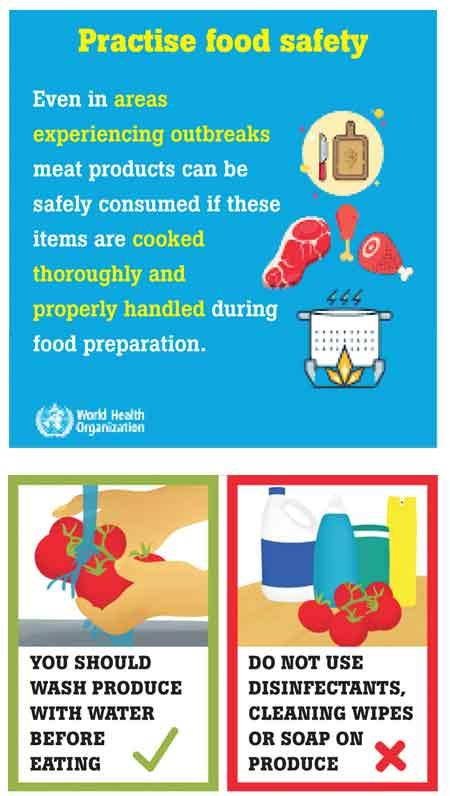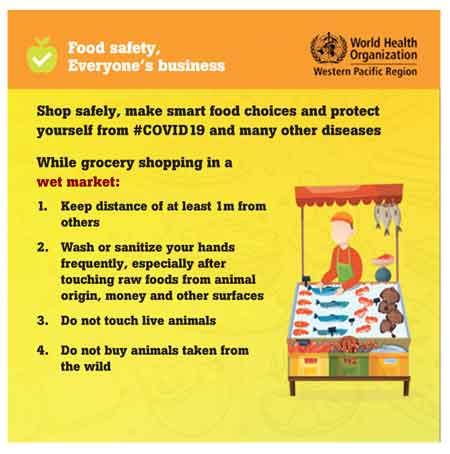
Coronaviruses, including SARS-CoV-2 (COVID-19), can remain viable and infective on various surfaces for sustained periods of time under controlled laboratory settings
Studies have found that the family of coronaviruses can survive in water for days or even weeks but surviving and ability to infect are two different things
Considering the available information on viral transmission, it is still advisable to take some protective measures to avoid virus transmission via contaminated surfaces and food, hence it is important to observe the general rules of everyday hygiene

During the early stages of the COVID-19 pandemic, many of us had wasted a lot of time thinking and bothering about the ways of contracting the disease through contaminated food, but here are some thoughts on the transmission of COVID-19 via food: The risk of transmission of COVID-19 from eating or handling food and food packages is deemed exceptionally low. To understand why it is unlikely to contract the disease from the food you eat, it is essential to understand how food-borne diseases are transmitted to humans.
Fundamentally, there are two ways of transmitting food-borne illnesses
When the food itself is intrinsically contaminated. This happens when you food, such as lettuce or red onions, are contaminated with a pathogen (an organism that causes disease, such as E. coli) that may have originated while it was growing possibly through contaminated water or introduced during distribution.
In certain instances, the pathogen usually persists in animals without causing infection to the animal, but they are harmful to humans. For example, chickens have salmonella and cattle carry E. coli, which will not make them sick but can cause illnesses in humans if meat is not cooked properly. If we do not act to either physically remove that pathogen or inactivate them, such as by cooking or washing food items, then these contaminated foods can cause food-borne illnesses in humans.
The second way of contracting a food-borne illness is when somebody who is handling the food is sick with a virus or bacteria and contaminates the food item during preparation. The most common ways for this to occur are through fecal-oral spread. For example, if someone with the norovirus, which is the virus that causes the stomach flu, does not wash his or her hands properly after using the restroom and then handles the food to be consumed, the individual who consume such food may well get the stomach bug as well.
Could COVID-19 be transmitted to humans through food?
The second kind of transmission is where an infected person handles food and it is the only way you could get COVID-19 from food, but it is unlikely because, in order for COVID-19 to have any potential food-borne contamination route the following conditions must be satisfied.
- Somebody would need to be sick with COVID-19 while preparing the food,
- Have a high enough viral load (the amount of virus a person has inside him or her),
- Cough or sneeze directly into your food , and
- The virus would have to be able to survive and persist in that food.
Transmission of COVID-19 via food is not an impossible scenario; nevertheless it is very unlikely you could get COVID-19 in this manner, because the virus that causes the disease can be killed at temperatures similar to that of other known viruses and bacteria found in food.
Transmission of COVID-19 Virus via Drinking Water
Studies have found that the family of coronaviruses can survive in water for days or even weeks but surviving and ability to infect are two different things. The U.S. Centers for Disease Control and Prevention (CDC) says ‘there is no evidence that COVID-19 virus can actually propagate or infect people via water’.
Essentially, drinking water supplies are usually purified as part of the treatment process that removes all harmful pathogens as well as viruses. Based on current understanding and research, the WHO says that ‘there is no indication that COVID-19 virus can persist in drinking water. Traditional, integrated water treatment methods that use filtration and disinfection should meaningfully decrease the concentration of COVID-19 virus. Other human coronaviruses have been found to be sensitive to chlorination and disinfection with ultraviolet (UV) light’. Hence, it is believed that the drinking water supply is not a route for transmission of the virus.
Experts argue that even if someone with COVID-19 handled your food and if that food is cooked or washed thoroughly with Chlorine treated water, it would inactivate or remove the virus.
Can COVID-19 virus be transmitted via milk from cows fed on possibly contaminated feed?
Currently there is no evidence that the transmission of COVID-19 via consumption of milk have taken place in China or other countries affected by this pandemic. And also, there is no indication of a particular role of feed for pets and livestock in COVID-19 transmission. And also, there is no evidence that animal feed is a vehicle for coronaviruses.
Can COVID-19 virus be transmitted via food packages/surfaces?
During the early stages of the pandemic, some experts and health authorities recommended disinfecting groceries and food packages or leaving nonperishables food items outside for a considerable time. However, as researchers have learned more about COVID-19, these precautions have proved unnecessary. That is because COVID-19 needs a live animal or human host to multiply and survive and cannot multiply on the surface of food packages.
The concerns of virus transmission via contaminated surfaces were based on many studies that have supported that Coronaviruses, including SARS-CoV-2 (COVID-19), can remain viable and infective on various surfaces for sustained periods of time under controlled laboratory settings. Hence, experts argued that Coronaviruses can generally reach surfaces through an infected person sneezing or coughing directly on them and remain infectious there for some time. Therefore, a smear infection to another person appears to be possible if the virus is transmitted shortly afterwards via the hands to the mucous membranes of the nose or eyes.
However, a recent study conducted by Israeli scientists suggested that though Coronavirus can survive in surfaces under laboratory conditions, in the real world viral survivability does not warrant the infectivity of the virus. The viral survivability and infectivity are different. Hence, researchers have suggested that ‘even in healthcare settings, infection control and prevention should focus mainly on the prevention of direct face-to-face transmission and droplet protection. Fomite transmission may still be a possibility with highly contaminated surfaces around patients throughout their most contagious stages of infection, and in closed and crowded environments.
Considering the available information on viral transmission, it is still advisable to take some protective measures to avoid virus transmission via contaminated surfaces and food, hence it is important to observe the general rules of everyday hygiene, such as washing hands regularly and keeping hands away from your face. There is no need to disinfect food packaging, but we should always practice good hand hygiene when handling food. Washing hands with soap for 20 seconds removes and kills the virus that causes COVID-19. Therefore, ‘we could kill and eliminate the viruses even if the virus is on that package that was brought into the house, by thoroughly washing the hands after handling it.
Can Covid-19 transmit via contaminated frozen food?
According to the latest information currently available on the WHO investigations in China (https://www.who.int/publications/m/item/covid-19-virtual-press-conference-transcript---9-february-2021), there is no evidence of clusters of infection with SARS-CoV-2 through the consumption of frozen food. The previously known fatal coronaviruses, SARS and MERS are insensitive to cold and can remain infectious at minus 20 °C for up to two years in a frozen state. According to a study, it was observed that SARS-CoV-2 on frozen meat had also lost barely little of its infectivity after three weeks. Thus, general hygiene rules for food preparation should be followed.
The good news is that currently there is no evidence to show that humans being infected with the new type of coronavirus through the consumption of contaminated food. And also, currently no consistent indication of transmission of the virus by means of contact with contaminated food packages, which would have led to subsequent human infections. However, transmission through smear infections through surfaces that have been contaminated with viruses cannot be ruled out.
Is it possible to cause Covid-19 respiratory tract infections through drinking containers, in food or in community catering facilities, such as restaurants or cafeterias?
To date, the oral/alimentary transmission route (through the esophagus and stomach) is not reported during this COVID-19 pandemic. Transmission mainly happens via droplets resulting from coughing and sneezing are absorbed by other people via the mucous membranes of the respiratory tract, and transmission via contact or smear infections of the pathogens that directly reach the mucous membranes of the nose or eye.
A virus contamination from drinking containers, such as drinking glasses, and in food would require the usage by an infected person, whereby the virus is transmitted to the glass via the hands/saliva. Subsequently, transmission to another person through mucous membrane contact with the glass may then occur if the container used by the infected person has not been adequately washed. But, to date infections with COVID-19 virus via this transmission process have not yet been established.
As coronaviruses are enveloped, in which the genetic material is coated by a layer of fat (lipid layer), react sensitively to substances that dissolve fat. Alcohol or surface-active agents, which are contained in soaps and dishwashing detergents as grease removers damage the virus surface and render the virus inactive. Although specific data is not yet available for Covid-19, it is likely that these substances would inactivate the virus.
A laboratory study carried out on the related SARS, coronavirus has established that treatment with a typical detergent for five minutes at room temperature led to full inactivation of the virus. Higher temperatures for a considerable time could increase the efficiency of virus inactivation. Cleaning drinking containers in dishwashers or glass washing machines at 60 °C or a higher temperature is, therefore, highly effective. If this is not possible, water with high temperatures (> 45 °C, but no higher than 50 °C, in order to protect the hands), along with detergent, should be used in manual rinsing processes. When using colder water, particular care must be taken to ensure that a sufficient amount of detergent is used, or that glasses are left in the sink for longer time, and that glasses are carefully cleaned mechanically, and thereafter dried.
Does it make sense to use disinfectants at home as well?
It appears that there is no need for healthy people to use disinfectants in their homes. Common hygiene measures, such as correct and frequent hand-washing with soap and regularly cleaning surfaces and door handles with standard household surfactant-based washing and cleaning agents sufficiently protect against smear infections with COVID-19. However, the targeted use of disinfectants may be fitting if recommended by a doctor in infected or affected homes, such as if an infected person lives in a quarantined home.
How to avoid COVID-19 when buying food or takeout
Despite the fact that there is no evidence that handling or consuming food is linked with COVID-19 infection, there are safety measures that you can follow to avoid getting the virus when collecting take away food, grocery shopping or visiting the local farmer’s market. These include:
- Wearing a mask in public;
- Remaining at least six feet from others;
- Using a hand sanitizer as soon as you return to your car and washing your hands thoroughly when you get home.
If there are no facilities for hand-washing outside of the home, care should be taken to adopt the following:
- That hands are kept away from the face,
- Not to shake hands with other people
- Washing hands thoroughly as soon as there is a chance to do so
- If this is not possible, wipes or an alcoholic hand sanitizers can be used while you are out.
Studies have shown that the virus can survive on different surfaces for significant amounts of time, in some cases several days. So, in theory, you could catch the virus from food or food packaging. Yet, Centers for Disease Control and Prevention (CDC) in the US states that, “currently, there is no evidence to suggest that handling food or consuming food is associated with COVID-19.” Moreover, the World Health Organization (WHO) has stated that “it is highly unlikely that people can contract COVID-19 from food or food packaging.”

While many types of bacteria can easily reproduce and grow on food, the same is not applicable for the SARS-CoV2 (Covid-19). This virus requires a surviving host to multiply. So, a sufficient number of viruses have to be deposited on the food and survive long enough for you to get infected when you either touch or eat the food. This in theory may happen if someone infected with the virus happens to proceed to cough all over the food. However, the virus on food moving down the gastrointestinal tract may not have the same opportunity to reach the respiratory tract. And it is not clear whether the virus can infect cells of the digestive tract.
Considering the available information, it can be revealing that transmission of the COVID-19 virus through food or food packaging is still a possibility, especially if a large enough dose of virus is placed on the food. Therefore, the best thing to do is to adopt following food safety measures.
Based on currently available research findings/evidence and if we were to practice above stated general food safety practices, it is prudent to say that food and food packaging is possibly not a major risk for transmitting the COVID-19 coronavirus infection. And the above stated food safety measures are helpful to prevent not only COVID-19 coronavirus infections but other much more common bacterial food-borne illnesses like Salmonellosis, Campylobacteriosis, Listeriosis, E.coli and Norovirus infections.

 During the early stages of the COVID-19 pandemic, many of us had wasted a lot of time thinking and bothering about the ways of contracting the disease through contaminated food, but here are some thoughts on the transmission of COVID-19 via food: The risk of transmission of COVID-19 from eating or handling food and food packages is deemed exceptionally low. To understand why it is unlikely to contract the disease from the food you eat, it is essential to understand how food-borne diseases are transmitted to humans.
During the early stages of the COVID-19 pandemic, many of us had wasted a lot of time thinking and bothering about the ways of contracting the disease through contaminated food, but here are some thoughts on the transmission of COVID-19 via food: The risk of transmission of COVID-19 from eating or handling food and food packages is deemed exceptionally low. To understand why it is unlikely to contract the disease from the food you eat, it is essential to understand how food-borne diseases are transmitted to humans. 



